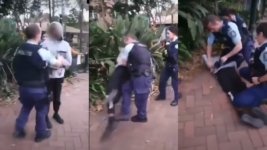The Use of Force by NSW Police Against First Nations Peoples Is Stark and Disproportionate

While it’s certainly not the first time the NSW Police Force has been pulled up in regard to the way it uses force on the beat by legal and civil society groups, new statistics put on the table by the Redfern Legal Centre on Monday, show that when it comes to First Nations people, officers let loose.
According to the data obtained by the inner-city legal centre, over the four years to June 2022, NSW police were responsible for applying the use of force in 28,826 incidents, and of these, 13,161 saw officers applying this force towards First Nations people.
To say that NSW police has a long history of prejudicial treatment of Aboriginal and Torres Strait Islander peoples is uncontroversial. Indeed, the first form of state law enforcement rolled out in the mid-1820s, was specifically established to deal with the First Peoples of the region.
However, a century later, even with the history of hostility towards the invaded, the fact that in 45 percent of cases where state law enforcement applies force officers are seen to continue to apply it towards First Nations people, 3.4 percent of the overall populace, is deplorable.
And this heavy-handed and disproportionate application of aggressive policing tactics is so disproportionate that not only does it lend further credence to the claim that the force has an issue with systemic racism, but it indicates that this bias is specifically directed towards First Nations.
Disproportionate to say the least
“The immense disproportionate use of force against First Nations people is appalling,” said RLC senior solicitor Samanatha Lee in a 31 July statement. “In 2021-22, almost half of NSW police use of force events involved a First Nations person.”
“The use of force is a systemic problem. It requires a systemic solution,” said the lawyer, who’s long tracked police behaviour. “The NSW police commissioner must address the use of force against First Nations people at all levels of the NSW Police Force, from recruitment to corporate reporting.”
Obtained under the terms of the Government Information (Public Access) Act 2009 (NSW), the figures further indicate that over those four years the percentage of use of force events rose from 44 percent of all incidents in 2018-19 to 47 percent of such events over 2021-22.
The first three years of this study, however, found that use of force incidents declined by 3 percent over 2018-19 to 2019-20, as well as by a further 12 percent in regard to 2019-20 and 2020-21. Although the last two years of the study saw use of force spike again by 3 percent.
In terms of the force being applied by NSW police officers towards Aboriginal and Torres Strait Islander individuals, arm restraints and wristlocks were the most commonly applied, followed by ground wrestles and take downs.
Excessive force spills over
Excessive use of force by NSW police officers has crept back into the headlines since 17 May, after NSW police senior constable Kristian White tasered a 95-year-old great-grandmother with dementia in a nursing home, as she was holding a steak knife and approaching with the use of a walking frame.
The woman, Clare Nowland, died in hospital a week later, which also happened to be the day prior to NSW police officers shooting a man four times. The victim, who had been holding two chief knives whilst having a mental health episode in a North Willoughby street, was killed instantly.
While a fortnight ago saw NSW police officers shot another man dead. He was holding a knife in a street in Glebe, Sydney’s inner west, after a number of officers had been called out to conduct a welfare check on him.
The Redfern Legal Centre obtained a copy of the 2022 NSW Police Force Use of Force Manual from the sole state law enforcement oversight body, the Law Enforcement Conduct Commission (the LECC), and published it on the day following the North Willoughby shooting.
Like the majority of NSW police powers, the ability to use force is set out in the Law Enforcement (Powers and Responsibilities) Act 2002 (NSW), which is commonly referred to as the LEPRA.
Section 230 of the LEPRA permits officers to use force, “as is reasonably necessary”, to exercise a function. Section 231 allows officers to apply force in making an arrest or preventing an escape from custody, whilst section 70 makes it possible to use force when entering and searching a premises.
However, nowhere in the LEPRA is there a section that provides NSW police officers with a lower threshold when applying use of force to First Nations people, which indicates that latent in this state’s law enforcement culture is the tendency to apply force to Aboriginal people more readily.
The colonial project
“These figures… should be collected at a national level and used to inform Closing the Gap reporting, which aims to overcome the entrenched inequality faced by too many Aboriginal and Torres Strait Islander people, so that their life outcomes are equal to all Australians,” Lee added.
Yet, the Australian government is well aware that this nation’s law enforcement has long taken a different and disproportionate approach to the policing of First Peoples, and, at least in inception, this excessive use of force was by design.
The overpolicing of First Nations peoples also leads to their disproportionate representation in this state’s correctional facilities and those right across the continent.
Right now, 30 percent of all adult in NSW gaols are Aboriginal and Torres Strait Islander individuals.
When initially encountered, the custody figures relating to First Nations peoples of this continent are jaw dropping, in much the same way as the policing statistics that the Redfern Legal Centre released earlier this week have been.
And the use of force statistics combined with Australian custody figures reveal that the settler colonial project launched here is far from over, and European law enforcement is being used in much the same way that it always has been on this continent: to secure it.
“The disproportionate impact of policing on Aboriginal and Torres Strait Islander people goes to the heart of the overrepresentation of Aboriginal and Torres Strait Islander people in the criminal justice system,” Lee concluded Monday’s statement.







